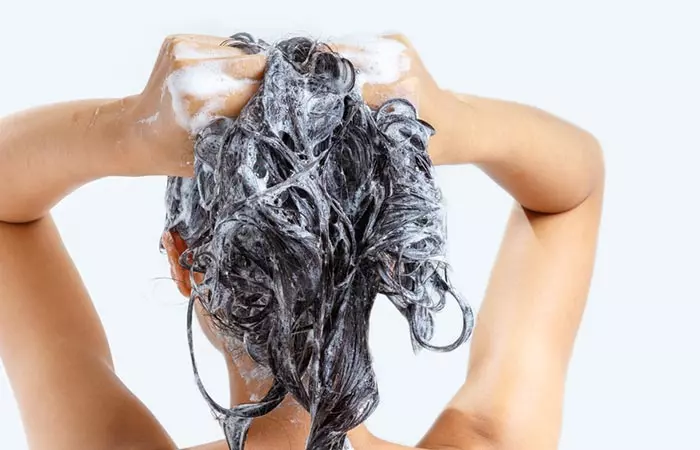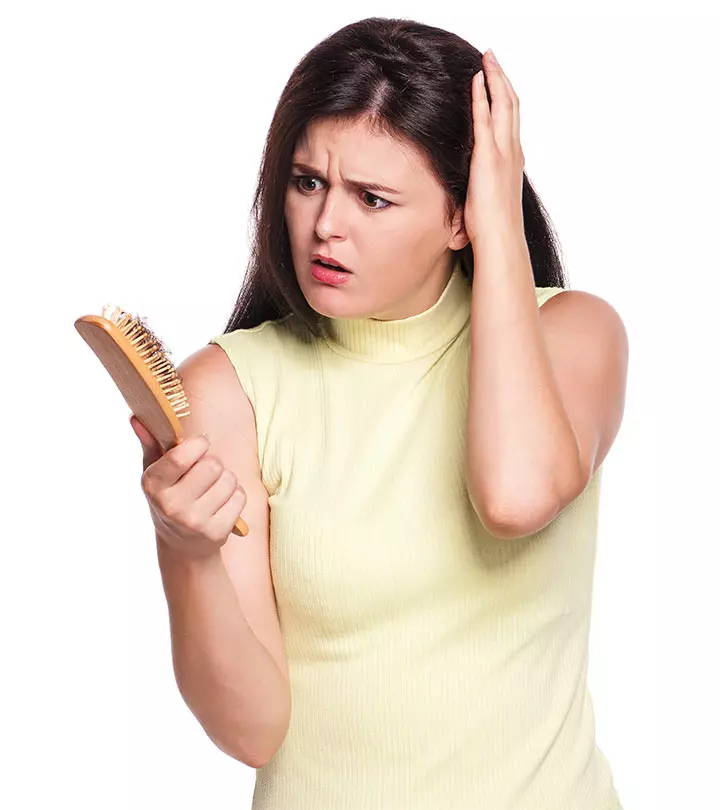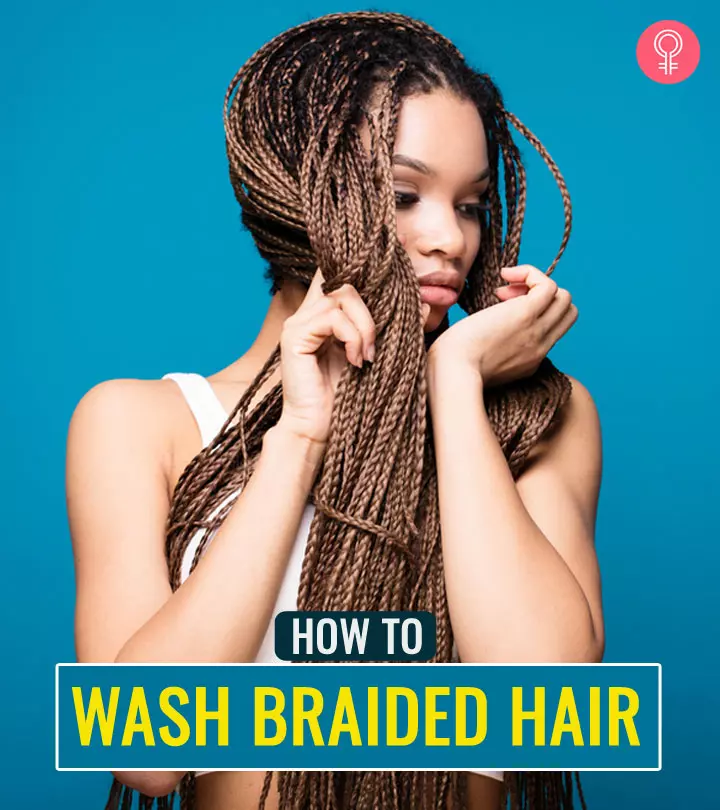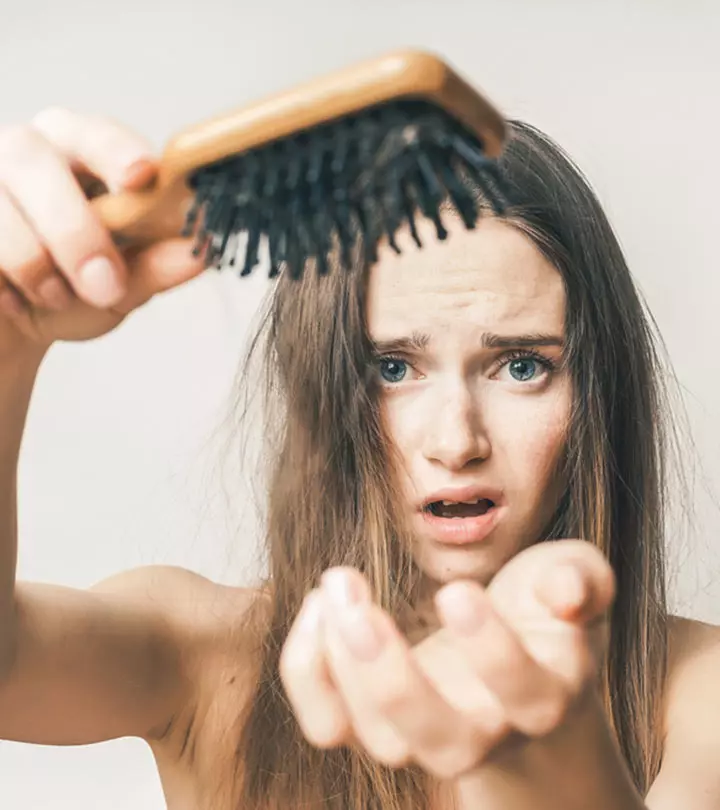Fleas In Human Hair: Treatments And Home Remedies
Yes, these pesky parasites can attack humans too. Here's how you can get rid of them!

Image: Midjourney/ StyleCraze Design Team
If you have a pet, you know they are at risk of getting fleas. However, finding fleas in human hair is even more worrying. Fleas feed on the blood of their hosts. Typically fleas infest pets, but they may bite humans. Though they cannot survive on human hair for long, fleas can cause allergies and transmit diseases. The following article discusses how to get rid of fleas in your hair. You will also find prevention tips for flea infestation in your hair. Take a look.
 Fun Fact
Fun FactIn This Article
Can Fleas Live In Human Hair?

Fleas generally cannot live in human hair. While most species prefer to live on the furs of animals, they can use humans as temporary vectors. In such cases, fleas can infest and bite humans. You may get infected if there is a serious case of flea infestation in your environment. Fleas can transmit various diseases and cause allergies and must be treated promptly.
There also are different types of fleas you might come into contact with, especially if you have pets. Being aware of them can help you take effective control and prevention measures. The four common types of fleas are (1):
- Cat flea (Ctenocephalides felis): Commonly found on cats, but can also infect dogs and other animals
- Dog flea (Ctenocephalides canis): Primarily affects dogs, but can also feed on other animals
- Human flea (Pulex irritans): Prefers to feed on human blood, but can also be found on domestic animals
- Rat flea (Xenopsylla cheopis): Infests rats and is known for transmitting serious diseases like the bubonic plague
 Did You Know?
Did You Know?Are you wondering if you have been infected by fleas? Find out how you can know in the section below.
Key Takeaways
- Fleas cannot survive in human hair, but they can temporarily infect humans and cause allergies.
- A flea bite can cause an intense itching on the scalp, as well as red bumps or pus-filled blisters (usually on the neck or scalp).
- Medicated shampoos and home remedies such as baking soda, apple cider vinegar, or tea tree oil can rid your hair of fleas.
How Do You Know If You Have Been Infected By Fleas?

Intense scalp itching followed by the appearance of red welts, bumps, or pus-filled blisters (usually on the neck or scalp) can be symptoms of flea bites. Individuals allergic to flea saliva may experience irritation, redness, and scalp inflammation. Beyond just being uncomfortable right away, fleas are known to be disease carriers and can present significant health hazards. Fleas can transmit diseases like typhus, a bacterial infection that can cause fever, headaches, and rash (2). Dr. Michael May, MBBS, FRCS, Hair Transplant Surgeon, says, “They can also trigger allergic reactions and secondary infections from scratching. For those concerned about scalp health, flea bites can irritate the skin, leading to inflammation or even temporary hair loss if excessive scratching damages follicles.” If the irritation and redness last up to 3 days or more, consult your doctor or a dermatology expert.
It is difficult to distinguish between human and animal fleas without a microscope or the proper knowledge of their anatomy. Hence, you must treat them if you experience any of the symptoms mentioned above. Scroll down to find out how to get rid of the fleas in human hair!
How To Treat Fleas In Human Hair?
Consider using anti-flea shampoos or sprays that are specifically formulated for human use.
- Shampoo:

A shampoo washes the fleas from the hair roots. Gently massage the shampoo into your hair and wait for 2 to 3 minutes. You can also use a wide-tooth comb or your fingers to remove the fleas from your hair. Some believe certain shampoo ingredients may irritate the fleas and help in their removal.
- Tea Tree Oil: Adding tea tree essential oil to your shampoo can help curb flea infestation. The oil is traditionally used (in its diluted form) to eliminate fleas in pets and on carpets, couches, etc. Research suggests that tea tree oil is effective in managing fleas (3).
- Baking Soda: While this remedy isn’t scientifically proven, anecdotal evidence suggests that baking soda may dehydrate and kill flea larvae and eggs. This is a natural, non-toxic remedy to treat fleas in human hair.
You will need
- 2 tablespoons of baking soda
- 10 ml of water
Process
- Mix the baking soda and water to make a thick paste.
- Apply this mixture to the scalp. You can use your fingertips to gently massage the scalp.
- Leave the mixture on for 10 to 15 minutes
- Rinse with lukewarm water.
- Apple Cider Vinegar:

It is widely believed that rinsing your hair with ACV can help eliminate fleas. Dilute the ACV with water in a 1:1 ratio and spritz the mixture into your hair using a spray bottle. Leave this on for 15 minutes and wash your hair with warm water. This remedy may also help reduce scalp itchiness.
Along with following these remedies for fleas in human hair, it is also important to clean your house well. Just as head lice live on pillows and sheets, fleas can too lay eggs on your beddings and can survive there until the eggs hatch! Cleaning them well will eliminate any pests that might be lingering and cause re-infestation.
Note: Consult a doctor for more treatment options if using home remedies does not reduce symptoms in a week or two.
If your symptoms persist despite these treatments, seek medical intervention. Once you treat the fleas in your hair, you may follow these precautions to prevent their recurrence.
Precautions To Prevent Fleas

- It is possible you have pets that could have been infected. Give them a bath with a specially formulated shampoo and a flea comb to get rid of any fleas or ticks. Protect yourself by wearing gloves while bathing your pet. A serious infestation would warrant a veterinarian’s advice for proper treatment.
- Wash your pillows, linen, towels, clothes, and other household items. Also wash all your pet beds, toys, and mats.
- Disinfect your hats and headgear or accessories by keeping them in sunlight for a few hours. You can even spray tea tree oil or apple cider vinegar to remove any fleas.
- Vacuum your carpets, curtains, rugs, and couches. Call pest control if there is a serious infestation.
- Clean or close any open garbage spaces around your home as they could be a source of flea infestation too.
You can also control and prevent flea infestation on pets and homes by following these methods (4):
- Topical Treatments: You can apply topical flea control products like imidacloprid monthly to prevent flea infestations on pets. Also, maintain consistent flea treatment schedules to keep pets and homes free from fleas
- Oral Medications: Administer oral flea growth inhibitors, such as lufenuron, to disrupt the flea life cycle and prevent population growth. You may also combine topical and oral treatments when necessary, especially in heavily infested households.
- Regular Sprays: You may try using pyrethrin-based sprays on pets every 1–2 weeks to kill adult fleas and reduce infestations.
- Environmental Monitoring: Place light traps in homes to detect and monitor flea activity early.
Katherine Edison, a blogger who focuses on nature-related content, shared her experience dealing with a flea infestation that affected her pet cat, her skin, and her room. Seeking a chemical-free solution, she opted for a simple light trap to tackle the problem. The light trap involves placing a shallow pan of soapy water under a night light near the floor. The light attracts fleas, which jump toward it, fall into the soapy water, and drown. She wrote, “Within a couple of hours I’d caught 25 fleas. A day later, I checked again and found about 10 more fleas. Fewer and fewer fleas jumped onto my feet. Within 2 weeks, using the trap and frequent vacuuming to get the eggs, we seem to be flea-free. I’m feeling pretty pleased (i)”.
Moreover, it’s important to continue following preventive treatments even after fleas are eliminated. This will help you avoid the risk of re-infestation.
Infographic: Flea Infestation
Fleas are a common nuisance that can cause pain, allergies, and even disease transmission in extreme situations. Although the ones that infest pets do not have humans as hosts, this does not imply they are wholly harmless. They may feed on your blood and live on human hair in certain circumstances.
Learn more about fleas, their lifecycle, what they may do to your pets, and typical treatment methods in the infographic below. Illustration: StyleCraze Design Team
Fleas in human hair lead to serious issues like scalp itching, redness, and inflammation. Since fleas feed on blood, they can infest human hair and scalps. They can bite the scalp and cause adverse reactions and diseases. Thankfully, there are some effective ways and shampoos to get rid of fleas. You can also try home remedies made with natural ingredients like apple cider vinegar, baking soda, and tea tree oil. The best way to prevent a flea infestation in your hair is to keep your pets and surroundings clean as well as be mindful of overall hygiene and hair care.
Frequently Asked Questions
Will fleas lay eggs in human hair?
No, fleas don’t lay eggs in human hair. Fleas cannot breed living off human blood. They lay eggs in cats, dogs, and other pet animals.
How long do fleas live on humans?
Fleas cannot live long in human hair, and our strands are not thick enough for them.
Will fleas go away on their own?
No. Once fleas find their host animal, they can stay on them, lay eggs, and cause an infestation.
Where do fleas hide in the bedroom?
Fleas need blood to survive. They will be found on animals or humans. But check your pillowcases, sheets, and mattress – as they can survive on inanimate objects for about 24-48 hours without blood.
Illustration: Fleas In Human Hair: Treatments And Home Remedies

Image: Stable Diffusion/StyleCraze Design Team
Struggling with fleas in your hair? Find the ultimate solution in this eye-opening video. Don’t wait—watch now and regain control over your hair and peace of mind!
Personal Experience: Source
StyleCraze's articles are interwoven with authentic personal narratives that provide depth and resonance to our content. Below are the sources of the personal accounts referenced in this article.
(i) Like a Moth to a Flame…or a Flea to a Nightlight
https://earthteachme.blogspot.com/2012/10/like-moth-to-flameor-flea-to-nightlight.html
References
Articles on StyleCraze are backed by verified information from peer-reviewed and academic research papers, reputed organizations, research institutions, and medical associations to ensure accuracy and relevance. Read our editorial policy to learn more.
- About Fleas
https://www.cdc.gov/fleas/about/?CDC_AAref_Val=https://www.cdc.gov/fleas/fleas_of_the_us.html - Flea Bites
https://www.ncbi.nlm.nih.gov/books/NBK541118/ - Treatment of tungiasis using a tea tree oil-based gel formulation: protocol for a randomized controlled proof-of-principle trial
https://www.ncbi.nlm.nih.gov/pmc/articles/PMC8323357/ - Control of fleas on pets and in homes by use of imidacloprid or lufenuron and a pyrethrin spray
https://pubmed.ncbi.nlm.nih.gov/10397062/
Read full bio of Tiffany Young
- Dr. Michael May, MD, is the Medical Director and Principal Surgeon of the Wimpole Clinic in Harley Street, London. He has 25 years of experience in the field of hair transplant surgery and has completed over 10,000 hair transplant procedures. He is the current president of the European Society of Hair Restoration Surgery, a registered member of The Trichological Society, and a Diplomat of Hair Restoration Surgery (ABHRS).
 Dr. Michael May, MD, is the Medical Director and Principal Surgeon of the Wimpole Clinic in Harley Street, London. He has 25 years of experience in the field of hair transplant surgery and has completed over 10,000 hair transplant procedures. He is the current president of the European Society of Hair Restoration Surgery, a registered member of The Trichological Society, and a Diplomat of Hair Restoration Surgery (ABHRS).
Dr. Michael May, MD, is the Medical Director and Principal Surgeon of the Wimpole Clinic in Harley Street, London. He has 25 years of experience in the field of hair transplant surgery and has completed over 10,000 hair transplant procedures. He is the current president of the European Society of Hair Restoration Surgery, a registered member of The Trichological Society, and a Diplomat of Hair Restoration Surgery (ABHRS).
Read full bio of Annie Jangam
Read full bio of Ramona Sinha
Read full bio of Monomita Chakraborty



























Community Experiences
Join the conversation and become a part of our empowering community! Share your stories, experiences, and insights to connect with other beauty, lifestyle, and health enthusiasts.